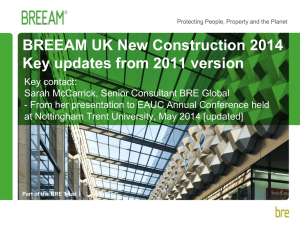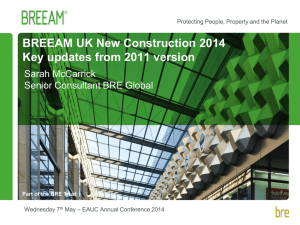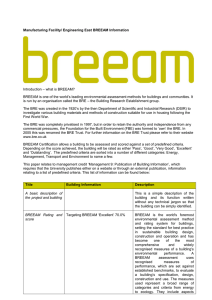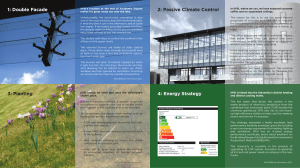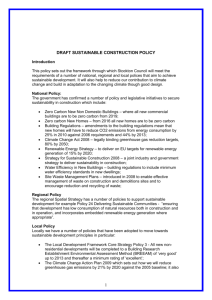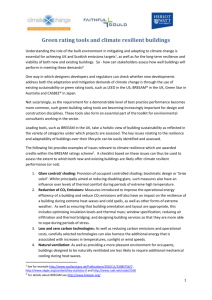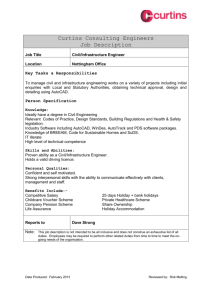BREEAM UK New Construction (NC) 2014 FAQs
advertisement
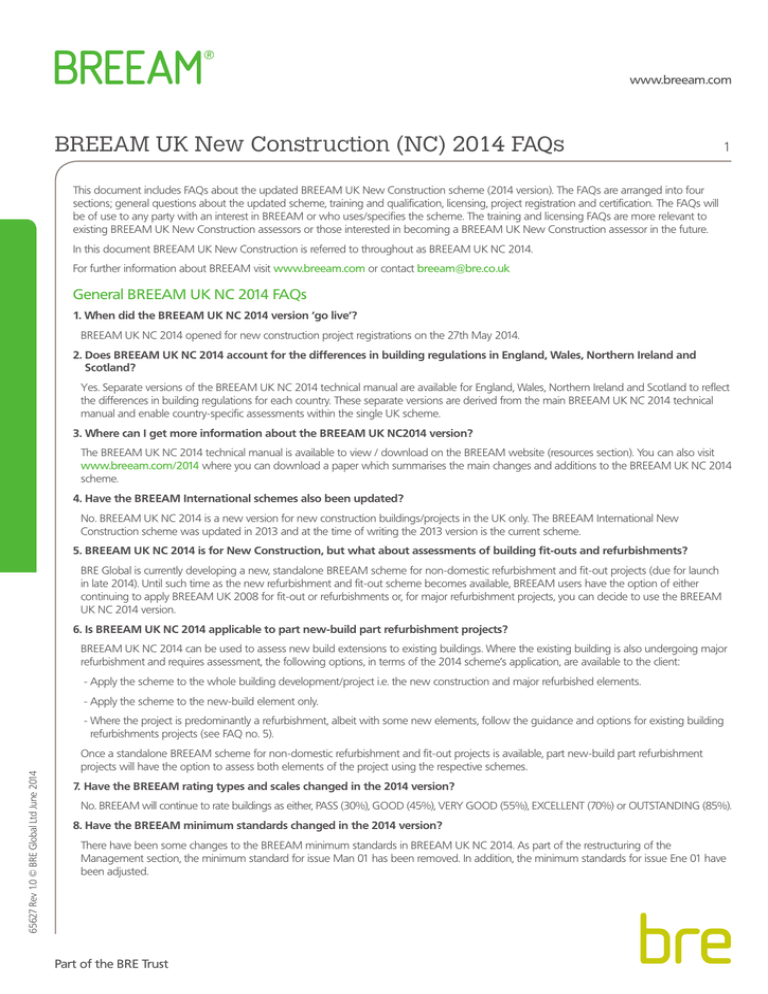
www.breeam.com BREEAM UK New Construction (NC) 2014 FAQs 1 This document includes FAQs about the updated BREEAM UK New Construction scheme (2014 version). The FAQs are arranged into four sections; general questions about the updated scheme, training and qualification, licensing, project registration and certification. The FAQs will be of use to any party with an interest in BREEAM or who uses/specifies the scheme. The training and licensing FAQs are more relevant to existing BREEAM UK New Construction assessors or those interested in becoming a BREEAM UK New Construction assessor in the future. In this document BREEAM UK New Construction is referred to throughout as BREEAM UK NC 2014. For further information about BREEAM visit www.breeam.com or contact breeam@bre.co.uk General BREEAM UK NC 2014 FAQs 1. When did the BREEAM UK NC 2014 version ‘go live’? BREEAM UK NC 2014 opened for new construction project registrations on the 27th May 2014. 2. D oes BREEAM UK NC 2014 account for the differences in building regulations in England, Wales, Northern Ireland and Scotland? Yes. Separate versions of the BREEAM UK NC 2014 technical manual are available for England, Wales, Northern Ireland and Scotland to reflect the differences in building regulations for each country. These separate versions are derived from the main BREEAM UK NC 2014 technical manual and enable country-specific assessments within the single UK scheme. 3. Where can I get more information about the BREEAM UK NC2014 version? The BREEAM UK NC 2014 technical manual is available to view / download on the BREEAM website (resources section). You can also visit www.breeam.com/2014 where you can download a paper which summarises the main changes and additions to the BREEAM UK NC 2014 scheme. 4. Have the BREEAM International schemes also been updated? No. BREEAM UK NC 2014 is a new version for new construction buildings/projects in the UK only. The BREEAM International New Construction scheme was updated in 2013 and at the time of writing the 2013 version is the current scheme. 5. BREEAM UK NC 2014 is for New Construction, but what about assessments of building fit-outs and refurbishments? BRE Global is currently developing a new, standalone BREEAM scheme for non-domestic refurbishment and fit-out projects (due for launch in late 2014). Until such time as the new refurbishment and fit-out scheme becomes available, BREEAM users have the option of either continuing to apply BREEAM UK 2008 for fit-out or refurbishments or, for major refurbishment projects, you can decide to use the BREEAM UK NC 2014 version. 6. Is BREEAM UK NC 2014 applicable to part new-build part refurbishment projects? BREEAM UK NC 2014 can be used to assess new build extensions to existing buildings. Where the existing building is also undergoing major refurbishment and requires assessment, the following options, in terms of the 2014 scheme’s application, are available to the client: -A pply the scheme to the whole building development/project i.e. the new construction and major refurbished elements. -A pply the scheme to the new-build element only. 65627 Rev 1.0 © BRE Global Ltd June 2014 - Where the project is predominantly a refurbishment, albeit with some new elements, follow the guidance and options for existing building refurbishments projects (see FAQ no. 5). Once a standalone BREEAM scheme for non-domestic refurbishment and fit-out projects is available, part new-build part refurbishment projects will have the option to assess both elements of the project using the respective schemes. 7. Have the BREEAM rating types and scales changed in the 2014 version? No. BREEAM will continue to rate buildings as either, PASS (30%), GOOD (45%), VERY GOOD (55%), EXCELLENT (70%) or OUTSTANDING (85%). 8. Have the BREEAM minimum standards changed in the 2014 version? There have been some changes to the BREEAM minimum standards in BREEAM UK NC 2014. As part of the restructuring of the Management section, the minimum standard for issue Man 01 has been removed. In addition, the minimum standards for issue Ene 01 have been adjusted. Part of the BRE Trust www.breeam.com BREEAM UK New Construction (NC) 2014 FAQs 2 9. Have the BREEAM section weightings changed in the 2014 version? Yes. Following a review of the section weightings for BREEAM UK NC 2014, adjustments have been made to the weightings for the following sections: Energy, Transport, Water, Materials, and Waste. In addition, new weightings have been introduced for shell only/shell and core projects. Please see the Scoring and Rating section in the BREEAM UK NC 2014 manual for more information. 10. How does BREEAM UK NC 2014 assess energy in comparison to 2011 version? The methodology for assessing energy within the Ene 01 issue is unchanged. However, the means of defining the baseline used for assessing the performance of a new building in each UK territory has changed in the 2014 version. In the 2011 version the England and Wales building regulation for energy (Part L 2010) was used to calibrate the Ene 01 translators in the UK scheme, and therefore all buildings assessed in the UK regardless of location used the same baseline. In the BREEAM UK NC 2014 version the energy related building regulation local to each UK territory are used to set respective baselines for the Ene 01 issue. For a more in-depth explanation of this and the Ene 01 methodology, download the BREEAM Guidance Note 12 – Ene 01 Methodology UK NC 2014 version (available from the Resources section of the BREEAM website). 11. Has the scope of BREEAM for new buildings changed in BREEAM UK NC 2014? BREEAM UK NC 2014 covers the same building types and assessment stages as BREEAM UK NC 2011. A separate refurbishment standard is currently under development (see also FAQ no. 5 on refurbishment projects). Under BREEAM UK NC 2014, building types fall within four broad sector categories; commercial, public sector, multi-residential and ‘other buildings’; each sector containing a sub-group of buildings which can be assessed using the 2014 version e.g. commercial sector includes offices, retail and industrial types. In addition to the building types covered by the BREEAM UK NC 2011 scheme, fire stations and visitor centres are included within the scope of the BREEAM UK NC 2014 scheme (see FAQ no. 12). Also, the criteria for Simple Buildings are fully integrated in the BREEAM UK NC 2014 scheme, whilst revised guidance is included for the assessment of shell and core projects. 12. H as the BREEAM UK NC 2014 scheme superseded the BREEAM Fire Stations and Forestry Commission Visitors Centre schemes? Yes. Following a review of the standalone New Construction schemes for fire stations and visitor centres, these schemes have been discontinued and new project registrations against these schemes closed on the 27th May 2014. From this date onwards, assessment of these building types fall under the BREEAM UK NC 2014 scheme and can be registered accordingly. BREEAM UK NC 2014 addresses all relevant issues from the superseded schemes, thereby ensuring the appropriate assessment of these building types. 13. What should I do if I want to assess my project under BREEAM UK NC 2014? Contact a licensed BREEAM assessor organisation. They will be able to advise you accordingly and register your project for assessment with BRE Global. A list of licensed assessors and their contact details is available from the Green Book www.greenbooklive.com 14. I’ve heard BREEAM is changing the way it requires evidence from assessors for the 2014 scheme, is this true? Fundamentally the evidence required to demonstrate compliance with BREEAM criteria has not changed. We have updated the guidance relating to the types of evidence required by the BREEAM Assessor for a 2014 scheme assessment. This has been done in an attempt to make clearer the flexibility in evidence types that exists and can be used to demonstrate compliance with BREEAM issues. And, therefore, the principles by which BREEAM defines ‘robust evidence types’ and operates the quality assurance process. BRE will be monitoring the application and interpretation of this new guidance through the QA process, seeking feedback from assessors and, if relevant, providing additional support/clarification and updates to issue/criteria specific evidence requirements. 65627 Rev 1.0 © BRE Global Ltd June 2014 BREEAM training and qualification FAQs 15. When will the first BREEAM UK NC 2014 assessor training course take place? The first assessor training course will take place in July 2014. Courses will be run on a monthly/bi-monthly basis from then on. Please refer to the Training & Events Calendar on the BREEAM website for further details. 16. What is the structure of the BREEAM UK NC 2014 exam / examination day? First time trainee assessors: the examination is undertaken in two parts on the same day. The first part of the exam consists of a paper that tests the delegates’ general understanding of the scheme and covers the operational aspects of BREEAM UK NC 2014 and the assessment process. The second paper of the examination covers the technical aspects of the BREEAM UK NC 2014 scheme. If the trainee passes the examination they become a qualified BREEAM UK New Construction non-domestic assessor. Any new trainee assessor that attends the updated full BREEAM UK NC 2014 scheme assessor training course and passes the exam will be qualified to assess all building types covered under the scope of the BREEAM UK NC 2014 scheme and can apply for the relevant sector licence. Part of the BRE Trust www.breeam.com BREEAM UK New Construction (NC) 2014 FAQs 3 17. If I train and qualify under BREEAM UK NC 2014 does that entitle me to also do BREEAM UK NC 2011 or BREEAM UK 2008 version assessments? Yes (provided you hold the relevant BREEAM licence for the building type requiring assessment and have reviewed and understand the technical criteria and tools for that version). 18. If I trained and qualified under BREEAM UK NC 2011 or previous versions does that entitle me to do BREEAM UK NC 2014 version assessments? Yes, existing assessors will be able to register and assess projects for the same building types and sectors that they hold a BREEAM licence. It is, however, recommended that existing licensed assessors complete the BREEAM UK NC 2014 online webinar and test before they start BREEAM UK NC 2014 assessments. This will allow assessors to demonstrate their understanding of the update. Where an assessor has not completed the online webinar and test, BRE Global will undertake a higher level of audit on their first 2014 assessment. Completing the webinar and test or selecting a higher level of audit at QA is necessary for demonstrating on-going assessor competency in the scheme. This is a requirement of the standards to which BRE Global operates BREEAM and is accredited by UKAS. 19. If I have recently trained in BREEAM, how long does my qualification remain valid? Provided you take out the relevant BREEAM licence within 12 months of qualifying you will remain qualified for the term in which the licence remains valid. If you remain unlicensed for a period longer than 12 months and then wish to become licensed, you will need to undertake full or partial re-training. Visit the BREEAM website or contact BRE at breeam@bre.co.uk for further advice and guidance on BREEAM training requirements. BREEAM licensing FAQs 20. Will the BREEAM licensing structure change with the release of the BREEAM UK NC 2014 scheme? The BREEAM UK New Construction scheme licence structure remains the same. In addition to the Core BREEAM licence there will continue to be four types of BREEAM licence, covering key sectors and building types: - Commercial buildings licence: e.g. offices, retail, industrial buildings - P ublic (non-housing) buildings licence: e.g. Education, healthcare, prisons and court buildings -M ulti-residential buildings licence: e.g. halls of residence, sheltered accommodation, barracks, residential care homes, key worker accommodation. -O ther buildings licence: e.g. other residential (excluding private dwellings) and non-residential institutional building types, assembly and leisure buildings and any other building type for which BRE Global has developed tailored criteria e.g. data centres etc. 21. Will the licence fees be changing, if so when and how can I find out what they are? The licence fees will not be changing with the release of BREEAM UK NC 2014. 22. Will the release of BREEAM UK NC 2014 affect my existing licence arrangement? Your existing licence arrangements and scope will not change with the release of BREEAM UK NC 2014. If you would like to make any changes to your licence agreement, please contact breeam@bre.co.uk FAO Licensing Department. BREEAM Assessors are reminded that the BRE Terms and Conditions require 30 days notice to terminate a licence and all licence fees are non-refundable. 65627 Rev 1.0 © BRE Global Ltd June 2014 BREEAM registration and certification FAQs 23. When does the BREEAM UK New Construction 2011 scheme close for registrations? In England, Wales and Northern Ireland the BREEAM UK NC 2011 scheme will close for new project registrations on the 30th June 2014. BRE Global will continue to accept previous version registration requests for BREEAM 2011 projects after this date, provided there is evidence of a contractual obligation to use that version. From 1st July 2014 BREEAM NC 2011 projects in England, Wales or Northern Ireland projects should be registered using the ‘previous version’ option on the registration extranet. Refurbishment and fit out projects can continue to be registered to the BREEAM 2008 version using the ‘Refurbishment’ option on the registration extranet. (see also FAQ no.5 on refurbishment projects). In Scotland, the BREEAM UK NC 2011 scheme will remain open to registrations until such time as Section 6 of the building regulations are updated in 2015 (date to be confirmed). Therefore, until registrations against the 2011 scheme in Scotland close, projects in Scotland can choose to be assessed against either BREEAM 2011 or BREEAM 2014 (at the discretion of the client). Part of the BRE Trust www.breeam.com BREEAM UK New Construction (NC) 2014 FAQs 4 24. Why is BREEAM UK NC 2011 open longer in Scotland than England, Wales and N. Ireland for project registrations? This is to reflect the timing of changes to building regulations in Scotland and to allow projects to continue to be registered under the BREEAM UK NC 2011 scheme until such time as changes to regulations come into effect. 25. Will the BREEAM UK NC certification fees be changing? Yes. BRE Global’s current BREEAM UK NC certification fees have been fixed since mid-2011. So, whilst the fee structure for BREEAM UK NC certification is not changing, the fees have been adjusted in line with inflation over the period. The updated fees will apply to any project registered for assessment against any BREEAM UK New Construction scheme version from 1st July 2014 onwards. BRE Global have published an updated fee sheet (FS036) on the BREEAM extranet. 26. Have the process/requirements for project registration changed? The process of registering a project will not change, however BRE Global have increased the registration fee as a proportion of the total certification fee. Please see the updated fee sheet FS036 for new registration fees. The registration fee is an upfront cost to cover the administrative and technical support for the project prior to submitting for certification and is non-refundable. Note: Assessors are reminded that assessments are registered to a licensed assessor company (who has an individual assessor qualified and licensed to carry out assessments of that project/ building type). If a registration is moved to another licensed assessor company (e.g. to maintain the version it was registered under) then a transfer of registration should be completed and the registration and certification fees current at the time of transfer will be applicable and charged to the new assessor company. 27. Will there be any changes to the Quality Assurance process for BREEAM UK NC 2014 assessments? The QA process will remain the same as it currently is for all BREEAM schemes. Our team of auditors have been given training on the technical changes to the new construction scheme, in-particular around the new guidance for evidence. 28. Will there be any changes in the certification process? The certification process will remain the same as it currently is for all BREEAM schemes. Certificates will be updated to state the new scheme version and reflect the scope of the assessment i.e. shell only, fully fitted, simple building etc. 29. A s an experienced assessor of previous versions of the new construction scheme, will I be subject to Full Audit on my first assessment under BREEAM UK NC 2014? BREEAM will conduct Full Audits on some of the first assessments submitted for QA after launch, to assist in early identification of any issues with the scheme. All assessors will be subject to a minimum of Partial Audit for their first BREEAM New Construction 2014 assessment submitted for QA, as part of on-going competency checks. 30. I have heard there will be greater flexibility for assessors under the new scheme. Does this mean I will be able to opt to disregard technical criteria within credits where I believe they are not relevant to the project in question? 65627 Rev 1.0 © BRE Global Ltd June 2014 BREEAM is keen to be flexible in respect of the evidence required to demonstrate compliance, provided the principles of robust evidence types are followed when verifying and referencing project information. Our aim is to ensure that few, if any, additional forms of documentation are required for the purposes of a BREEAM assessment. However, all applicable criteria need to be addressed by assessors where BREEAM credits are being awarded. The only exception to this is where BRE Global confirms, via a technical query response, that one or more criterion may be disregarded, or applied in a different way for a particular assessment or scenario. BRE Global has strived to ensure that the 2014 assessment criteria is, where possible and practical, non-prescriptive. The aim of which is to allow the flexibility in the scheme to recognise different solutions that achieve the same outcome, i.e. the mitigation of a particular BREEAM assessed environmental, social or economic impact. However, flexibility in the criteria is counter-balanced by the need to ensure consistency in the application of the methodology by different assessors/project teams on different projects, and therefore maintain the comparability of the BREEAM rating. Part of the BRE Trust
